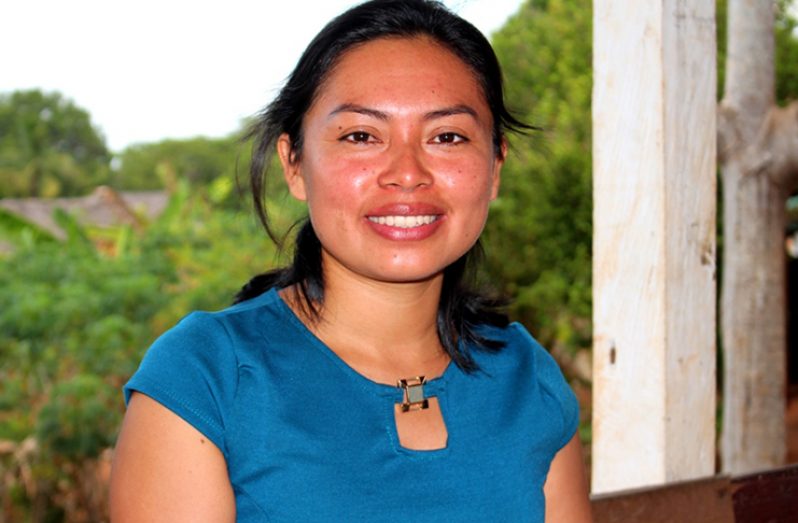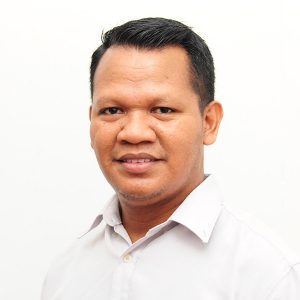— university graduate returns to Aishalton to teach language to children
INTRODUCING a language which was traditionally spoken by your ancestors to the schools where you live can be challenging, especially when the education system revolves around an English-speaking curriculum.
But the task becomes easier when you were raised in an environment where the language is the primary means of communication. For Leah Cassimero, a proud Wapichan descendant, the aim of ensuring the tradition is passed down from her ancestors remain alive and is firmly set within her sight.
Cassimero, a University of Guyana (UG) graduate, grew up listening to her parents and relatives in the deep South Rupununi village of Aishalton speaking the Wapishana language (also referred to as Wapichan).
She fluently speaks the language and her job as academic coordinator of the Quality Bilingual Education Programme for Wapichan (QBEP) children, allows her to realise a dream; one which she told the Guyana Chronicle is to see the language being revived in Wapichan villages and become part of the primary school curriculum farther outside the Rupununi.
After months of discussions, the project grew to fruition in July 2018 when a Memorandum of Understanding (MoU) between the QBEP and the education ministry was signed and both parties agreed to introduce the language course at three pilot schools in Region Nine. These schools are Maruranau, Sawariwau and Karaudarnau nursery schools. Aishalton was identified as the pilot village for the project’s implementation.
Cassimero told the Guyana Chronicle that prior to implementation of the project, the schools needed re-assurances that the Ministry of Education was fully on board. As time progressed, the ministry and the project planners agreed on the MoU. “When we got that paper, it gave us the assurance we needed and the communities were fully behind it,” she said in elated tones.
BEING INVOLVED
Cassimero said in 2017, she was in her final year of academic studies at UG, pursuing a Degree in Business Management, when she was contacted by the project coordinators. She said although there was some amount of awareness of the project in the Rupununi, she did not know much of what was happening.
Cassimero said the Wapichan people who live mainly in the South Rupununi, look forward to quality education, one that involves their culture.
She said to keep the language and culture alive, it boils down to educating the children using their own language; leaving it aside would be a travesty, she said.
”Whatever initiative we think of, it all comes down to education; if our people are educated, we will be empowered enough to make proper decisions for ourselves,” she added.
She said in 2017 when she finished her last exam at UG, she pondered what her next move would have been.
“And then I got an email where they asked if I would like to fly down to the Rupununi to meet a resource team who were trying to start a programme for Wapishana children,” she said. Cassimero did not know what to expect on her return to the Rupununi, but when she arrived she said she was amazed that the group, which was working voluntarily on the programme, was advancing something she dreamed about.
The group was meeting with Minister of Indigenous Peoples’ Affairs Sydney Allicock and senior Education Ministry officials at the time and Cassimero described the scenario as “major.”
“So I had to be there,” she said. After familiarising herself with the project, she said the group encountered a few bottlenecks which needed to be ironed out and at the end, she was asked if she wanted to take part in the programme on a full- time basis — she accepted.
Cassimero is wary of the fact that when indigenous youths complete their university studies, many may not want to return to their hometowns to contribute to their (hometowns) development. “So this gave me that opportunity, one where I can actually work at home and work with the language , so I was coming back home to work,” she said with a smile.
The young lady worked voluntarily for the first three months on the project “to get a feel of the project,” as she wanted to do something for her people.
Cassimero also writes competently in the Wapichan language. She recalled that after completing secondary school, she enrolled in a Wapichan literacy programme offered in the village. ”I passed the exam and so this project gave me an opportunity to utilise the knowledge I gained from that literacy programme,” she said.
UNIVERSITY STUDIES PUT TO PRACTICE
The young woman noted too that she utilises the project management skills she attained while reading for her degree.
“It was a good chance for me to use those technical skills and I saw the potential of everyone and I decided to fit in the more technical aspect of the job and gathering information and processing that in English and in Wapishana,” she said.
She said initially there was some fear from the instructors when the project was being rolled out. That fear, she said, revolved around the guidelines within which the Ministry of Education operates. However, she said the teachers were given assurances by the project planners that they were there to assist.
FEEDBACK
After the first school term was completed last December, Cassimero said the good points and the “not-so-good points” of the project were listed. “The good one is that children are being able to communicate in the Wapichan language,” she said, as she noted it was a huge plus for the project’s progression.
“People get the idea that the bilingual education language is about teaching language alone, but because children are already speaking the language, it is just a means of communicating and at this point it is for the child to be comfortable speaking his or her own language,” she added.
She said one of the things which need strengthening is the availability of teaching materials. For this school term, she said the plans were restructured. “I have very high hopes for this term,” she said and she said too that the project is being delivered to ensure results.
At the moment, Cassimero is hosting a radio programme which is tied to the project. The programme, which is hosted on Radio Aishalton, was launched last weekend when the United Nations’ International Year of Indigenous Languages celebrations were held at the village.
“Right now I am dedicating all my energies towards the project to see that it is successful,” Casimero said with a smile.



.jpg)








